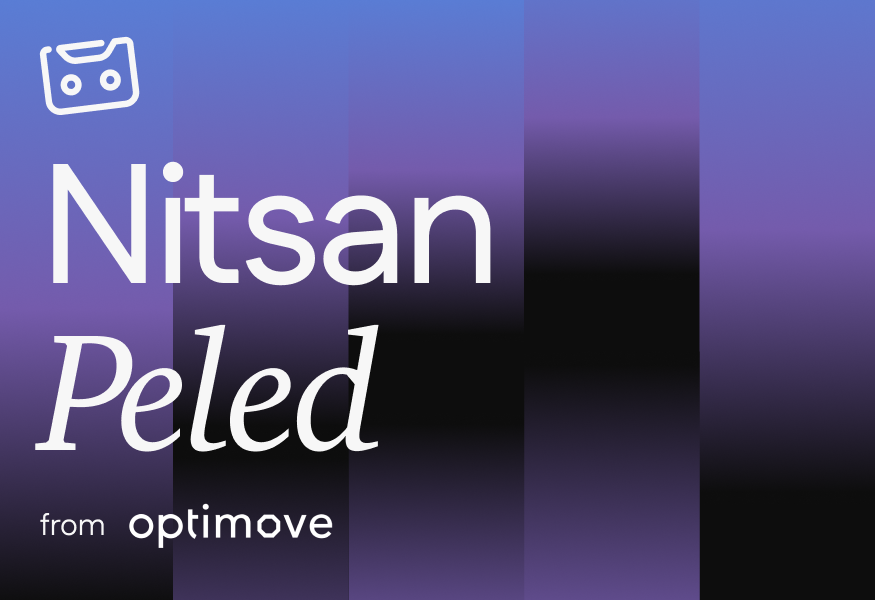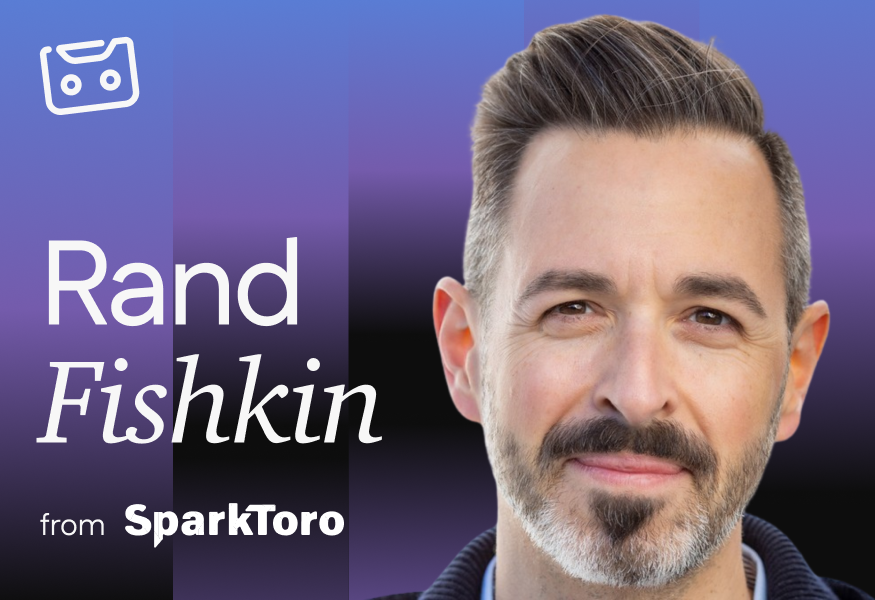When Nitsan Peled joined relationship marketing platform Optimove as its new Director of Content, he arrived with a distinct advantage.
His background wasn’t entrenched in B2B.
Nitsan came up in the 24/7 news cycle of sports journalism, where deadlines are tight and stories must make an instant connection to see the light of day.
This helped give him an outsider's perspective of where many B2B companies were going wrong and what was needed to create content that stood out.
And that’s what the key takeaways from Nitsan’s episode of Demandist will help you learn: how to create content that captures attention and amplifies your brand.
Your content must move people and elicit emotions
Something that Nitsan learned from his experience in sports journalism—and being around other sports journalists—is that content should always resonate with the reader on a personal level.
As he crossed over into the world of tech, he quickly realised that the human aspect wasn’t something widely practised in B2B:
“When I started moving into tech and reading more and more B2B blogs, I found that most of them were probably written by the same freelancer somewhere sitting somewhere and writing them, right? They all look the same, feel the same, they start the same or they [leave out] even [an] attempt to move people.
“It doesn't matter if it's B2B or B2C, it's eventually a person that is buying your product and consuming your content. The better you connect with them on an emotional level, the stronger you resonate with them, the more meaningful the experience you give them, the better chances are [that] they will eventually purchase your product.
“If one-day procurement for B2B companies [is] all done by robots [...] maybe then B2B and B2B sales would be completely different. But as long as it's people that are a part of the decision process, then adding this relevancy, this day-to-day human touch into everything that you write, can help you stand out.”
To work this human element into your own content, Nitsan has a tried and trusted technique that he’s carried with him since childhood:
“My trick that I took from growing up reading sports magazines, is to look for the day-to-day — the daily reference. Mention it in the first paragraph and then in some way or another loop back into it with the final sentence of the post.
“It's a trick, it works almost every time.
“Sometimes when it's too hard to come up with it. I won't force it. So I'll just go without it. So then maybe 20% of our blog posts won't have any of this. But the rest of the time, when it's easier and it comes naturally, it doesn't feel too forced.
“It’s just like the wrapping of something, right? It's the beginning and the end. And in the middle. There's a bunch of graphs and it's interesting.”
Think about how what you’re writing relates to the reader. What stories, anecdotes, or analogies can you share that will have them nodding along in agreement?
Don’t just present information, create connections.
Building a strong editorial brand raises all ships
Your blog is one of the best tools at your disposal to increase brand awareness, engagement, and thought leadership.
More than eight in ten content marketers blog and over 55% say they’ve gained new customers for their efforts. It’s as proven a marketing tactic as they come.
Optimove themselves has a successful blog, publishing several fresh articles every week. It also has a standalone relationship marketing publication called PostFunnel, which goes against a core principle of blogging.
That being, running a company blog is seen as one of the best ways to drive traffic to your website. Every new blog post you publish is one more indexed page, one more opportunity to show up in search engines and one more piece of content to link to on social. It’s a way to get people on to your site, from where they can explore and you can target them with links to different pages and products.
With a standalone publication, you risk missing out on those benefits.
So why do it? To control the conversation:
“Optimove not just believes, but knows, the value of great content for their marketing efforts and sales efforts.
“For us, PostFunnel allows us to make sure [there is a] conversation about the importance of CRM in B2C and what is CRM in B2C and talk about the problems of relationship marketing in B2C.
“First of all, [it’s] just to make sure that [the conversation is] happening day in and day out. Someone is writing about it, there's social media [content] about it, there's newsletters, there's interviews. So we're keeping the conversation going without even mentioning Optimove or our features.
“Second, it helps us frame the conversation and lead it towards the places that we know help eventually Optimove close a deal.
“If the entire conversation in B2C CRM would be about, let's say, brand equity [...] it does not help Optimove because of the bigger name players in the market. But if we can steer the conversation to be around orchestration and AI [and] multi-channel marketing, that helps us because that's where we're great.
“And if you can convince generations, you know, of CRM marketeers that those are the important things that will drive your business forward if you do CRM in B2C properly, then they will grow up and mature as marketeers understanding that a solution such as Optimove is best for them.”
By creating first-class content, PostFunnel points readers that want to learn more in the direction of the Optimove blog. This has helped Optimove create “micro-funnels,” making PostFunnel a standalone site a profitable source of referrals:
“[PostFunnel is] responsible for about 1% of the Optimove traffic. That's it. Just 1% of the traffic. But it's responsible for almost 10% of downloads.”
If you have a secondary target market where you’re not as well known, following Optimove’s lead in creating a standalone platform that’s driven by informative content can help you to gain a foothold, establishing your brand as a go-to solution without hard selling.
Let your teams and experts inspire topic ideation
If thought leadership and referrals are the two biggest benefits of running an additional publication, one of the biggest drawbacks is surely content creation. How do you come up with enough ideas to keep the conversation going across two websites?
For Optimove, content is driven by things people are talking about:
“I have a list of almost 30 topics. I compiled this list [...] the first month after I joined the company by talking to everyone — all the team leaders, all the different departments — taking the most important topics for them.”
Each month, the team starts with this list of keywords and checks off the topics that they have content planned for. They then come up with multiple ideas for each topic in order to provide ample coverage every month, involving internal subject matter experts and freelance writers in the ideation process.
These ideas dictate whether the content will feature on the Optimove blog or PostFunnel:
“The only thing that matters is the level of where it sits on the funnel, right?
“If we talk about it on a higher level, in a more industry trends level [or] in a more one-on-one level — get to know something, some tips and tricks, those kinds of things — it will go to PostFunnel.
“If you're already a CRM marketeer and you just want to get better at doing this or that, then most likely, you will find that kind of piece on the [Optimove] blog, where it would be more specific.”
PostFunnel articles are then linked-to relevant articles on the Optimove blog, which builds out these micro-funnels over time and encourages readers to interact with both platforms.
To create your own list of keywords and topics to target, find out what people are talking about:
- Look at the data: Dig into your analytics to see what keywords and phrases people are using to find you
- Ask your team: Talk to sales and customer service reps about the questions and queries customers are raising
- Conduct keyword research: Use tools like Google Trends, Ahrefs Keyword Generator or Answer the Public to discover popular search terms and topics
- Conduct market research: Run customer surveys or search for what your target audience is talking about on social media and sites like Quora and Reddit by entering industry keywords in the search field
Use this information to emulate Nitsan’s approach. Come up with several topic ideas around each keyword or theme, and spin this list into hundreds of potential unique pieces of content.
If you want to appeal to a brand, talk about them
As well as creating content aimed at potential customers at different stages of the funnel across the Optimove blog and PostFunnel, Nitsan and his team have a strategy to target specific brands on their account based marketing (ABM) list.
How do they build these relationships and entice them? Create content that’s dedicated to them:
“In the past year, we started talking specifically about [a] quite long, but a finite list of brands that are on the target list of [our] ABM system. So instead of chasing long-tail keywords, we are chasing specific brands.”
While targeting specific brands is nothing new, how Optimove go about it is much different from typical features-driven sales content:
“We took from Netflix’s book. So if [for example] we want to talk about segmentation, we come up with a series with a title or topic. And then we break it down into chapters. And we find someone to write those chapters.
“We come up with seven episodes, so most likely, each episode would be dedicated to a specific brand.”
Each piece looks at what the target brand is doing around a specific topic. This allows Optimove to:
1. Showcase their brand knowledge by demonstrating that they’ve thoroughly researched how a brand operates.
2. Showcase their market knowledge by demonstrating their industry knowledge and expertise
3. Deliver value to readers by breaking down brand processes and providing insights and tips for anyone with an interest in the topic
But simply putting the content out there is no guarantee of it falling into the lap of the intended audience.
To make sure it’s seen by the right people, Optimove takes to social media, using their sales reps to share content with brand marketeers that they’re already connected to. This way, it’s a more personal approach:
“It's a little less intrusive. They know each other, you know. They're connected to LinkedIn. And it's not completely out of the blue."
To bring us full circle, it’s that human element. And that makes all the difference.
Meet the makers
Maker Mixtapes is a podcast about the entrepreneurs, creators, and marketers building impressive things in their field. From content marketing to YouTube and growth, agency life to e-commerce and SaaS, this podcast aims to dissect and share lessons from their success.
Listen to Nitsan and other episodes from the brightest minds in tech and business on Spotify or Apple Podcasts.











